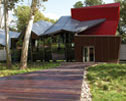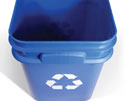After 18 years of exposure to extreme desert heat, the roof system on the Nationwide® Scottsdale Insurance Co. headquarters building in Scottsdale, Ariz., began to deteriorate. The maintenance staff had been chasing leaks for nearly five years when Nationwide Scottsdale Insurance decided to hire Alan Stevens Associates Inc., Cedar Rapids, Iowa, to solve the problem and replace the roof system.
The building's original roof system was a ballasted EPDM membrane over 4 inches of polyisocyanurate insulation on a concrete roof deck blanketed with a 2-inch-thick layer of river rock. The roof system was becoming a liability with regard to structural integrity (from water damage), maintenance costs and energy consumption.
The new roof system was installed by Starkweather Roofing Inc., Phoenix, in December 2008 and consists of 3 inches of polyisocyanurate board insulation set in roof adhesive over the concrete roof deck and a self-adhering base sheet and self-adhering white laminated polymer-modified bitumen roof membrane over the top. The membrane's surface is a reflective white film laminate with a solar reflectance index (SRI) value of 84.
In July 2009, the Arizona Cool Roof Council asked Starkweather Roofing to conduct a case study to determine whether white roofs truly are cooler and more energy-efficient than nonwhite roofs. The Nationwide Scottsdale Insurance building's roof was an ideal choice for the in-depth study.
Energy efficiency
On the morning of Aug. 6, 2009, Sherm Robison, lead estimator for Starkweather Roofing, and I installed HOBO® temperature data loggers from Onset Computer Corp., Bourne, Mass., directly onto the roof surfaces and in the low-traffic, non-air-conditioned and nonvented stairwells of the Nationwide Scottsdale Insurance building and the neighboring Wells Fargo Financial Services building in the same corporate plaza (which still has its original ballasted EPDM roof system in place, including the same amount of insulation that was on the Nationwide Scottsdale Insurance building's original roof system).
Obtaining rooftop and interior temperature data from two different buildings was beneficial because the results would be based on identical weather conditions instead of data from one year to the next on the same building where many variables could affect the results. The two buildings are almost identical in height and construction.
The temperature sensors on the roof surfaces were secured under the new materials used in each of the current roof systems to prevent direct sunlight from affecting the readings and provide an accurate surface temperature for each building. The temperature sensors placed in the stairwells were secured 3 feet from the roof hatches and directly to the underside of the concrete roof decks to measure the roof systems' energy efficiencies; in other words, they measured how much heat was being transferred through the concrete deck into the buildings' interiors.
The sensors measured the roof surface (the top of the membrane) and stairwell temperatures for both buildings once per hour, 24 hours per day from Aug. 6, 2009, to Sept. 4, 2009. Official temperature data for Scottsdale during the same time period and at the same time intervals also were obtained. During the data collection period, Scottsdale primarily had hot, sunny days—with a few monsoon storms sprinkled in—allowing for excellent test conditions.
The study's conditions were near-perfect for various reasons. First, we had virtually identical buildings that are side by side. Second, the Wells Fargo Financial Services building had an old roof system and the Nationwide Scottsdale Insurance building had a new roof system—we could do a before-and-after analysis at the same time and under the same conditions. Finally, concrete decks are not typical in Arizona (plywood decks are more common), so if the data proved any significant increase in energy efficiency in a building of this construction (with a concrete deck), we would know even better results could be gained in a building that has a plywood deck because heat transfers through plywood at a faster, more intense rate than it does through concrete.
Analysis and conclusions
The first thing that caught our attention when observing the study's results was the significant reduction of internal thermal variation, which is caused directly by the cool roof system's consistent temperature range.
In Figure 1, notice that between 10 p.m. and 6 a.m., the buildings have similar internal temperatures but the Wells Fargo Financial Services building always is hotter than the Nationwide Scottsdale Insurance building during the day. At 8 a.m., the Wells Fargo Financial Services building begins to heat up dramatically while the Nationwide Scottsdale Insurance building remains virtually unchanged. Figure 2 shows between 5 p.m. and 8 p.m., the Wells Fargo Financial Services building cools down faster than it heated up and the Nationwide Scottsdale Insurance building's internal temperature again remains constant.
Figure 1 also demonstrates how internal temperatures change as a result of outside temperatures. Notice how the Nationwide Scottsdale Insurance building's temperature holds steady all day while the Wells Fargo Financial Services building's temperature fluctuates rapidly. There is an average range of only 2 degrees in internal temperature from the hottest to the coolest parts of the day inside the Nationwide Scottsdale Insurance building. Conversely, the Wells Fargo Financial Services building typically has an 8-degree range of internal temperature during a 24-hour period. For buildings as large as these two, a nearly 8-degree range means a lot in terms of the additional energy required to maintain a consistent temperature for the buildings' tenants.
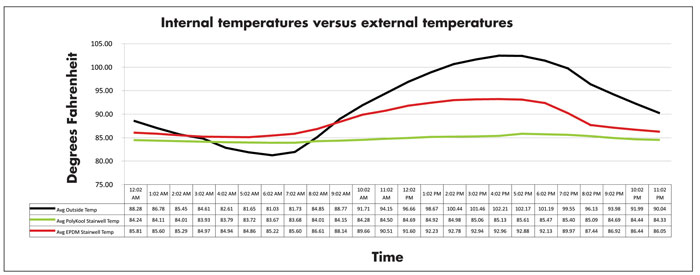
Figure 1: Average internal stairwell temperatures versus average external temperatures
During August 2008, the Nationwide Scottsdale Insurance building consumed 719,000 kilowatts (kW) of electricity. According to Chris Peterson, lead facilities technician for the Nationwide Scottsdale Insurance building, all other items remained virtually unchanged when compared with 2008, and the self-adhering white laminated polymer-modified bitumen roof membrane installation was the only substantial difference in 2009. During August 2009, the kilowatt consumption was 663,000 kW—a nearly 8 percent decrease (or $5,450 saved) in electricity required to cool the building, deeming it more energy-efficient.
Again, this is on a building with a concrete roof deck. Also, note that the cool roof cap sheet has an SRI value of 84. If the building had a plywood roof deck and if the materials' SRI value used was higher (100 is typical of most high-quality roof coatings), the energy savings would be even greater. Starkweather Roofing has begun performing similar analyses using buildings with plywood roof decks and higher SRI value roof coatings to compare the results.
On average, the Nationwide Scottsdale Insurance roof system is 12 degrees cooler than the Wells Fargo Financial Services roof system—but that includes overnight when there is no solar gain from direct sunlight. Therefore, the study results include temperature readings from during the night when sunlight isn't increasing the roof's surface temperature.
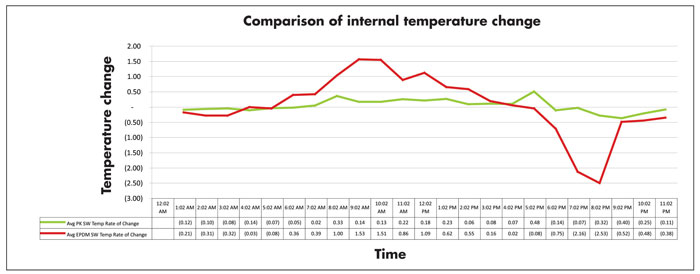
Figure 2: Average rates of change of internal stairwell temperature
Figure 3 shows that during the study, the largest difference in roof surface temperature occurred at noon when the average outside temperature was 97 F. The Wells Fargo Financial Services roof system on average was 156 F at that time, but the Nationwide Scottsdale Insurance roof system was only 129 F. That's a difference of 27 degrees. Between 9 a.m. and 5 p.m. (maximum sunlight hours), there is an average 22-degree difference in roof surface temperature, which is quite significant regarding the long-term survival of rooftop equipment (most rooftop equipment isn't constructed or warranted to last as long in such extreme temperatures), as well as the health of the building's facilities workers who have to perform work on the roof.
Benefits
Peterson says the new roof system has given Nationwide Scottsdale Insurance, as well as the building's maintenance staff, peace of mind.
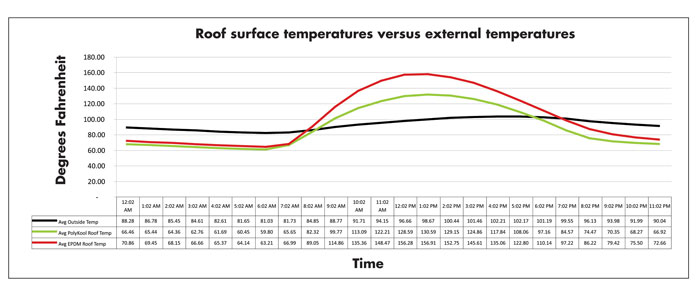
Figure 3: Average roof surface temperatures versus average external temperatures
"The cool roof does not leak and is easy to clean and keep free of debris," Peterson says. "We used to try to clean up the old roof, but the rock ballast made this task next to impossible. The surface is so much cooler now that you can place your hand on it midday without discomfort. Sunglasses now are mandatory for all workers because the reflectivity is like sunshine on snow.
"Our utility bill has shown a consistent monthly drop in kilowatt-hour (kWh) use since the roofing project's completion," he continues. "A conservative estimate of power reduction is around 50,000 kWh per month during midsummer. The building's air-conditioning demand has dropped tremendously. The cooling tower load has decreased so much I rarely have all four towers online. With the old roof system, we used all four towers from June to October to satisfy the building demand."
So the answer to the Arizona Cool Roof Council's question is clear: By obtaining rooftop and temperature data from an EPDM roof system and a self-adhering white laminated polymer-modified bitumen roof membrane and comparing the results, we now know without a doubt that white roof systems truly are cooler and more energy-efficient than nonwhite roof systems.
Chris Walker is a senior technologies project manager contracted by American Express, New York. He is a former employee of Starkweather Roofing Inc., Phoenix.

